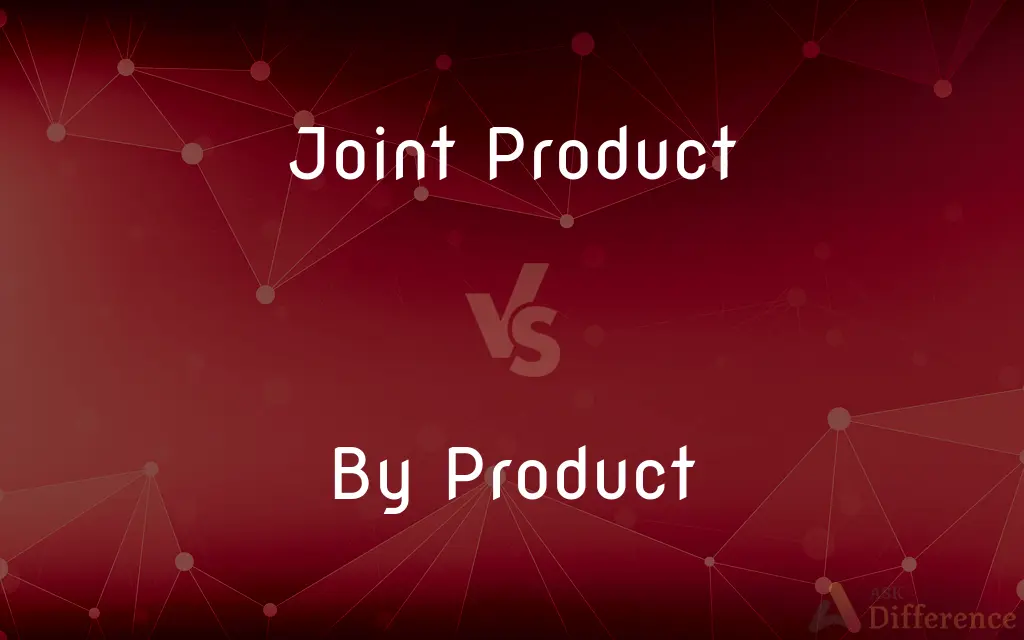Joint Product vs. By Product — What's the Difference?
By Tayyaba Rehman — Published on October 1, 2023
Joint Products are main products derived simultaneously from a process, while By Products are secondary outputs of lesser value.

Difference Between Joint Product and By Product
Table of Contents
ADVERTISEMENT
Key Differences
Joint Product and By Product both originate from a singular production process. However, while the Joint Product is one of the main products produced intentionally and has a significant value, the By Product is an incidental output with relatively lesser importance and value.
In industries like petroleum, Joint Products might include gasoline and diesel, both emerging from the refining of crude oil and holding significant market value. On the other hand, By Products like paraffin wax, while valuable, aren't the primary focus of the refining process.
It's essential to understand that the distinction between Joint Product and By Product isn't necessarily about quantity. It's more about the relative importance and the economic value of the outputs. For example, in meat processing, both meat cuts and hides can be considered Joint Products, while bones used for broth might be seen as By Products.
The allocation of costs in accounting varies for Joint Products and By Products. Joint Products often involve an allocation of joint costs based on some consistent basis like weight or sales value. By Products, conversely, might have their revenue treated as a deduction from the total joint costs.
Marketing and sales strategies for Joint Products and By Products also diverge. Joint Products often have dedicated marketing campaigns, whereas By Products might be sold in niche markets or even given away if the cost of processing isn't justified by potential revenue.
ADVERTISEMENT
Comparison Chart
Importance
Main product with significant value.
Secondary product with lesser value.
Intentionality
Produced intentionally.
Incidental output.
Economic Value
Generally high economic value.
Relatively lower economic value.
Cost Allocation
Joint costs allocated based on weight/value.
Revenue might offset joint costs.
Marketing Strategy
Dedicated marketing campaigns.
Niche markets or minimal marketing.
Compare with Definitions
Joint Product
Co-primary products with notable market value.
In the sugar industry, sugar and molasses are viewed as Joint Products.
By Product
Incidental product with lesser market value.
Glycerin is a By Product in soap manufacturing.
Joint Product
Significant outputs sharing joint costs.
When extracting metal ores, different metals can become Joint Products.
By Product
Output not central to the main production goal.
In milling, bran is often considered a By Product.
Joint Product
Products of equal importance from a singular process.
In meat processing, meat and hides can be considered Joint Products.
By Product
Product with value, but not the primary focus.
While processing fish, fish oil is typically a By Product.
Joint Product
A main output from a shared production process.
Gasoline and diesel are Joint Products from oil refining.
By Product
A secondary output from a production process.
Paraffin wax is a By Product of oil refining.
Joint Product
Multiple primary goods produced simultaneously.
In dairy, cheese and butter can emerge as Joint Products.
By Product
Something produced in the making of something else.
By Product
A secondary result; a side effect.
By Product
A secondary product; something made incidentally during the production of something else.
By Product
A side effect.
The many Indian restaurants all over Britain are a by-product of the large waves of immigration from the subcontinent.
By Product
A secondary or additional product; something produced, as in the course of a manufacture, in addition to the principal product.
By Product
A secondary and sometimes unexpected consequence
By Product
A product made during the manufacture of something else
By Product
Unintended yield from primary production.
In wine-making, grape seeds emerge as a By Product.
Common Curiosities
How are joint costs allocated to Joint Products?
Costs are usually allocated based on weight, volume, or sales value.
Can both Joint Products and By Products be profitable?
Yes, both can be profitable, but Joint Products often have higher economic value.
What's a key difference between Joint Product and By Product?
Joint Product is a main output with high value, while By Product is a secondary output with lesser value.
Can the status of By Products change over time?
Yes, with market demand or innovative uses, By Products can gain significance.
Why are Joint Products significant in accounting?
They require allocation of joint costs, affecting profitability analysis.
Are By Products always produced in smaller quantities?
Not necessarily. It's more about economic value than quantity.
How are By Products typically marketed?
They might target niche markets, have minimal marketing, or even be given away.
Are Joint Products always intentional?
Generally, yes. They are intentionally produced for market demand.
How do companies decide on producing Joint Products?
It's based on market demand, production feasibility, and profitability.
Can a By Product become a Joint Product?
If its economic importance grows, a By Product can become a Joint Product.
Do all industries produce By Products?
Not all, but many industries have processes that yield By Products.
Is the distinction between Joint Product and By Product always clear?
No, it can be subjective, based on market dynamics and company perspectives.
Can a By Product be a waste product?
Not necessarily. While some By Products can be waste, many have economic value.
Are By Products always sold?
Not always. Some might be recycled, reused, given away, or discarded.
Do Joint Products always share the same production process?
Yes, they emerge from the same process, which incurs joint costs.
Share Your Discovery

Previous Comparison
Beautiful vs. Irresistible
Next Comparison
Freud vs. JungAuthor Spotlight
Written by
Tayyaba RehmanTayyaba Rehman is a distinguished writer, currently serving as a primary contributor to askdifference.com. As a researcher in semantics and etymology, Tayyaba's passion for the complexity of languages and their distinctions has found a perfect home on the platform. Tayyaba delves into the intricacies of language, distinguishing between commonly confused words and phrases, thereby providing clarity for readers worldwide.
















































